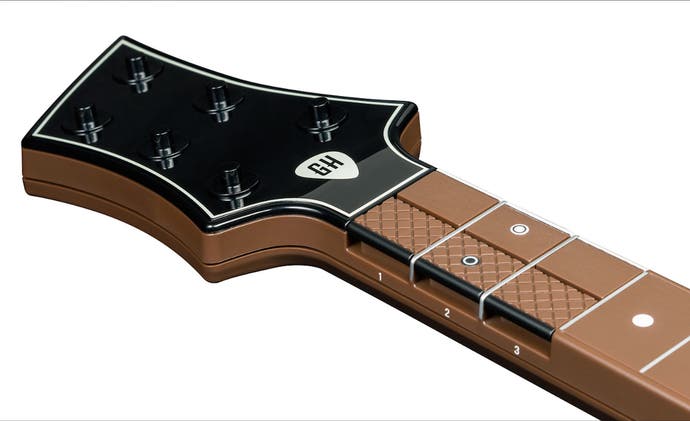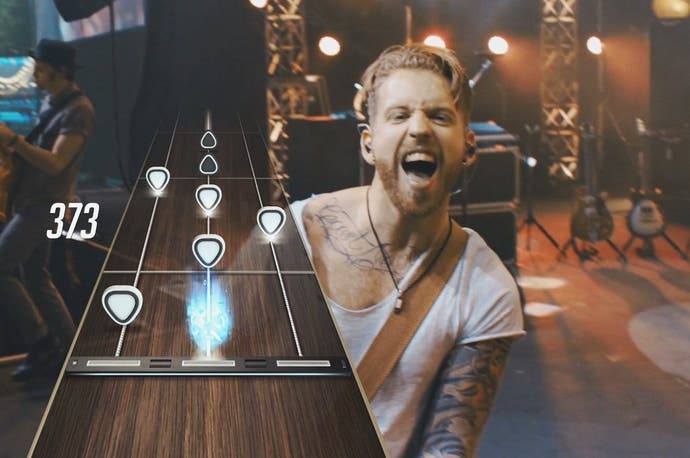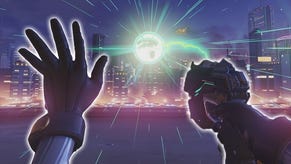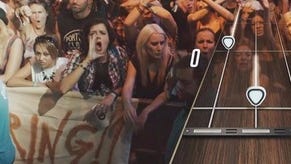Guitar Hero Live review
MTV crib.
After a solid week of back-to-back shows, I've just about got to grips with Guitar Hero Live's new visual vocabulary. It's a three-lane bowling alley where ergonomic icons scroll smoothly into strum bar range, a blizzard of black-and-white plectrums and the odd liquorice allsort hurtling down the familiar endless guitar-neck highway. It's taken some physical graft and a little mental rewiring, but ramping up the difficulty level feels like it has been worth it: there are pleasing nuances to uncover among the challenging punchcard patterns.
It also feels appropriate for the subject matter. Notable albums of yesteryear are spruced up using the latest production technology, digitally polished to a sheen to justify being resold to a new generation. For anyone who's wielded a plastic instrument in the past, Guitar Hero Live feels like something similar: a classic inviting you to remaster it.
But if something has been lost in this determined push to make a well-worn mechanic seem new, it's that in previous Guitar Hero games, it felt easier to wing it on the higher difficulty settings. Faced with a labyrinthine solo that looked like a roadie had accidentally tipped a bowl of M&Ms over your highway, you could sometimes let your fingers take over, intuiting the gatling-gun inputs required to bodge your way through.
The double-decker buttons of the new Guitar Hero controller restrict that sense of widdly abandon, demanding much closer attention and application. It may still be satisfying to ace the skittering, tropicana fretwork of a track like Girls by the 1975, but it's feels more like an intellectual achievement. It took me a while to figure out what the snappy black-and-white icons reminded me of but it was the chunky interlocking chevrons of an old Rubik's Snake puzzle. At the expert level, Guitar Hero Live, for good or ill, tickles some of the same brain centres.

It's also a game of two distinct halves, which could be characterised, respectively, as a genuinely dazzling promo and a slightly more ramshackle Bob Dylan-style endless tour. The audaciously presented campaign mode has already been criticised in some quarters for being ephemeral, but that might be the point. Playing predetermined sets as various Drive Shaft-like faux bands at the luxuriously imagined Rock The Block and SoundDial festivals might not scream long-term appeal, but perhaps the maximalist presentation was conceived to achieve just one aim: to launch this new incarnation of the franchise spectacularly hard and fast, then simply drop away.
The Guitar Hero Live campaign mode is essentially a booster rocket, and probably cost about as much to make. That isn't necessarily a bad thing - it feels like the unlimited cash and overreaching effort usually poured into putting together a knock-em-dead E3 demo have been passed on directly to the player. It's a sizzle reel made playable and, in the eyes of both the target market and the mass audience, makes the visual identity of its main rival look, and feel, like a rather outdated cartoon. It's a bid to achieve superiority through spending, and the results are - in the short term - spectacular.
Since 2007, every conversation about Guitar Hero has involved Rock Band and vice-versa. Both games ask players to wrap their hands around a substitute guitar neck, and it's easy to imagine the two franchises in a similar mutual death-grip, crowding out each other's share in what must be a finite marketplace and potentially risking mutually assured destruction if neither surrenders.
What Guitar Hero Live's revamped input mechanic and peacocking career mode achieves for the first time in their shared existence is that suddenly it doesn't take a trained eye to tell the two franchises apart from screenshots. (Not that social media is suddenly going to be flooded with Guitar Hero Live victory snaps - on PS4, all the usual share functions are disabled from the outset. But then, rhythm action has never been a genre that looked particularly exciting or distinctive in screengrabs.)
The battle lines of the renewed rivalry aren't as clear-cut as the early messaging has suggested. Rock Band 4 lets you jam with older instruments, sure, and you can reactivate your previously assembled (and paid for) music library. But in some ways, Guitar Hero Live is the franchise that's unfurling rope ladders over the side of their new zeppelin to help lapsed players clamber on board. Unlike RB4's new fixed baseline of PS4 and Xbox One platforms only, Guitar Hero Live calls back to the previous generation by being available on PS3, Xbox 360 and even Wii U.

So perhaps it's no coincidence that the new Guitar Hero branding bears more than a passing resemblance to JJ Abrams's revamped Star Trek logo. It's a glorious moonshot, a similar attempt to aggressively freshen things up without completely torpedoing what people loved. But it's what comes after - in the form of the GHTV streaming music channel mode - that will ultimately count.
Even with its three currencies and various ways of levelling up, there's nothing too complicated about Guitar Hero TV: anyone who's played a freemium iPad game will get the gist. There are two free-to-play 24-hour music channels with rotating playlists drawn from over 200 songs, although at this stage, the half-hour programming blocs are necessarily pretty basic: the schedule includes Exceptional Rock, Rock Top Hits, Rock Bites Back and Rock Takes Control. The inclusion of slick, woozily soundtracked channel idents and the use of authentic music videos make Guitar Hero TV feel like a fairly accurate simulation of MTV in the mid-2000s, not least because you never seem more than 10 minutes away from the video for Stacy's Mom by Fountains Of Wayne. The matchmaking, such as it is, has been rock-solid.
It can be fun to leave yourself at the mercy of a playlist, allowing random songs to wash over you as you build up coin reserves, granting you the option to unlock new guitar power-ups, profile idents and customised highways. The GHTV playlist also throws in some Guitar Hero tracks that veteran players will regard with something like fondness, from the cheesecake Cherry Pie by Warrant to the rigorous judder of Thunder Kiss 65 by White Zombie. Even original avatars like Johnny Napalm, Judy Nails and Lars Ümlaüt live on, even if only as invisible ghosts.
Their names populate the scoreboards of the GHTV premium scoreboards, where you can spend a "play" token or Hero Cash - which you buy with real-world money - to access new content early. The demanding Avenged Sevenfold premium content pack, employing live festival footage, feels like a useful bridge between Guitar Hero Live's two modes, and points to a possible future direction where bands could tailor content to the game rather than relying on preexisting videos.

But there does seem to be a disconnect between the focused play style required to make progress and the hangout vibe of channel-surfing Guitar Hero TV. All the matchmaking goes on behind-the-scenes, so the thrill of playing against other players in real-time is dulled, even as ten of you compete to get the highest score. The streamlined two-player mode is also competitive rather than collaborative, and assembling your own playlist requires spending a whole lot of play tokens, though they are rarely in such short supply that you are required to pay actual money. There's also the option of forking out £3.99 for the Guitar Hero Live party pass, a ballroom blitz that gives you unfettered access to the entire song catalogue for 24 hours.
Will this new freemium approach get the necessary traction? Rock Band 4 has clung to the old idea of multiplayer being collaborative and fun, acknowledging that players like to muck about and cannily rolling improvised vocal and guitar solos up into the core gameplay. Guitar Hero Live seems more focused on leveraging a steely single-player score attack impulse, with the whole package calibrated toward maximising riff streaks, deploying buffs to eke out the biggest score in what is essentially a fixed challenge. It demands complete control from the player, but never puts the player in complete control.
If this is just a development cycle starting over again, then Guitar Hero Live is a reasonably solid foundation to build upon. The bolted-on vocal mode is welcome but functional, leaving plenty of room for improvement. It's also easy to imagine how drums might appear in the future, or even some sort of turntable, considering how large DJ Hero looms in the FreeStyle Games hinterland. But moonshots are all about momentum. And while Guitar Hero Live is dazzling in the early running, it doesn't feel particularly optimised for the long haul. The flexibility of its new status quo means it could make some course corrections but for now, it falls just short of being recommended.
















